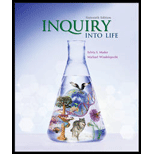
To determine:
The relationship between energy and the basic characteristics of life.
Introduction:
The energy is defined as the capacity to perform a task. All the living organism/cells require energy to perform the basic functions of the life.
Explanation of Solution
Energy:
The sun is the major source of energy for organisms and the ecosystems. Producers use energy from sunlight to make food. Cells need energy in order to survive. This energy is used to perform functions such as growth, maintaining balance, repair, reproduction, movement, and defense. This means all living organisms must obtain and use energy to live.
There are seven metabolic functions which make difference between living organisms and non-living organisms.
- Respiration Respiration is the release of energy from food substances in all living cells. Living things break down food within their cells to release energy for normal metabolic activity.
- Nutrition Living things take in materials from their surroundings that they use for growth or to provide energy. Nutrition is the process by which organisms obtain energy and raw materials from nutrients such as proteins, carbohydrates, and fats.
- Excretion All living things excrete. As a result of the many
- Growth Growth is seen in all living things. It involves using food to produce new cells. The permanent increase in cell number and size is termed growth.
- Movements All living things follow a specific pattern of movement. This may be observable, such as animals that are able to walk, or less observable, such as tropism in plants. The movement may be so slow, that it is very difficult to see.
- Sensitivity All living things are able to sense and respond to stimuli around them such as light, temperature, water, gravity, and chemical substances.
- Reproductions All living organisms have the ability to produce progeny. Only living organisms possess all of these characteristics.
All living organisms share the basic properties of life that are energy, which categorizes them as living and non-living beings. Energy is needed for the function of movement and standard metabolism.
Want to see more full solutions like this?
Chapter 6 Solutions
Inquiry Into Life (16th Edition)
 Human Anatomy & Physiology (11th Edition)BiologyISBN:9780134580999Author:Elaine N. Marieb, Katja N. HoehnPublisher:PEARSON
Human Anatomy & Physiology (11th Edition)BiologyISBN:9780134580999Author:Elaine N. Marieb, Katja N. HoehnPublisher:PEARSON Biology 2eBiologyISBN:9781947172517Author:Matthew Douglas, Jung Choi, Mary Ann ClarkPublisher:OpenStax
Biology 2eBiologyISBN:9781947172517Author:Matthew Douglas, Jung Choi, Mary Ann ClarkPublisher:OpenStax Anatomy & PhysiologyBiologyISBN:9781259398629Author:McKinley, Michael P., O'loughlin, Valerie Dean, Bidle, Theresa StouterPublisher:Mcgraw Hill Education,
Anatomy & PhysiologyBiologyISBN:9781259398629Author:McKinley, Michael P., O'loughlin, Valerie Dean, Bidle, Theresa StouterPublisher:Mcgraw Hill Education, Molecular Biology of the Cell (Sixth Edition)BiologyISBN:9780815344322Author:Bruce Alberts, Alexander D. Johnson, Julian Lewis, David Morgan, Martin Raff, Keith Roberts, Peter WalterPublisher:W. W. Norton & Company
Molecular Biology of the Cell (Sixth Edition)BiologyISBN:9780815344322Author:Bruce Alberts, Alexander D. Johnson, Julian Lewis, David Morgan, Martin Raff, Keith Roberts, Peter WalterPublisher:W. W. Norton & Company Laboratory Manual For Human Anatomy & PhysiologyBiologyISBN:9781260159363Author:Martin, Terry R., Prentice-craver, CynthiaPublisher:McGraw-Hill Publishing Co.
Laboratory Manual For Human Anatomy & PhysiologyBiologyISBN:9781260159363Author:Martin, Terry R., Prentice-craver, CynthiaPublisher:McGraw-Hill Publishing Co. Inquiry Into Life (16th Edition)BiologyISBN:9781260231700Author:Sylvia S. Mader, Michael WindelspechtPublisher:McGraw Hill Education
Inquiry Into Life (16th Edition)BiologyISBN:9781260231700Author:Sylvia S. Mader, Michael WindelspechtPublisher:McGraw Hill Education





